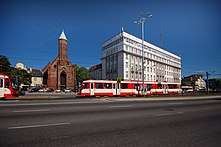Martial law in Poland
Martial law in Poland (Polish: Stan wojenny w Polsce) refers to the period between 13 December 1981 and 22 July 1983, when the authoritarian communist government of the Polish People's Republic drastically restricted normal life by introducing martial law and a military junta in an attempt to throttle political opposition, in particular the Solidarity Movement. Thousands of opposition activists were imprisoned without charge and as many as 91 killed.[2] Although martial law was lifted in 1983, many of the political prisoners were not released until a general amnesty in 1986.
| Martial law in Poland | |||||||
|---|---|---|---|---|---|---|---|
| Part of the Soviet reaction to the Polish crisis of 1980–1981 | |||||||
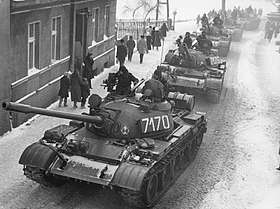 Polish T-55 tanks enter the town of Zbąszyń while moving east towards Poznań, 13 December 1981 | |||||||
| |||||||
| Belligerents | |||||||
Supported by: |
Supported by: | ||||||
| Commanders and leaders | |||||||
| Lech Wałęsa | |||||||
| Strength | |||||||
|
Initial strength:[1]
| ~ 10 million (1981) | ||||||
| Casualties and losses | |||||||
| Unknown |
| ||||||
Since the 1970s, communist Poland was in a deep economic recession. The First Secretary Edward Gierek made large incessant loans from western creditors to achieve a better economic output that instead resulted in a domestic crisis. Basic goods were being heavily rationed which acted as a stimulus for the establishment of a first anti-communist trade union in the Eastern Bloc, known as Solidarity, in 1980. Gierek, who permitted the trade union to appear per the Gdańsk Agreement, was dismissed from his post less than a month later under pressure from the USSR and confined to house arrest. Poland's already somewhat liberal policies concerning the opposition were worrisome for hardliners in the neighbouring Soviet Union, who feared that the Poles may overthrow communism and ally themselves with the Western Bloc. The Soviets were particularly uneasy as the departure of Eastern Bloc's most populous nation from Comecon would trigger further financial and economic problems that would bring an end to communist rule in Central-Eastern Europe. After a series of strikes and demonstrations by employees of chief industrial regions, Poland was directly heading towards bankruptcy.
The Military Council of National Salvation was formed by the new First Secretary of the Polish United Workers' Party, General Wojciech Jaruzelski, who was determined to put an end to the demonstrations and crush the opposition by force if necessary. There is speculation whether Jaruzelski instigated martial law to prevent bloodshed if the Soviets and other Warsaw Pact countries were to enter Poland under the mutual assistance treaty, like in the Hungarian Revolution of 1956 and the invasion of Czechoslovakia in 1968. On 13 December 1981, Jaruzelski announced the introduction of martial law in a televised speech addressed to the entire nation. The Polish People's Army, Citizens' Militia (MO), ZOMO special units and tanks rolled onto the streets to scare off demonstrators, begin regular patrols and maintain curfew. Intercity travelling was forbidden unless a permit was granted by the authorities, food shortages intensified and censorship was placed on all media and post. The secret services (SB) wiretapped phones in public booths and state institutions.
On 16 December, pro-Solidarity miners organized a strike against the declaration of the martial law at the Wujek Coal Mine in the industrial city of Katowice. The ZOMO squads, nicknamed "Communist Gestapo" by the opposition, brutally pacified Wujek, which resulted in the deaths of 9 miners. All other demonstrations across Poland were met with an armed force of the services, which utilized water cannons, tear gas, batons, truncheons and clubs to disperse crowds and beat protesters. Thousands were detained and some were tortured in state prisons. On 31 August 1982, in the copper-mining town of Lubin, 3 people were mortally wounded by ZOMO. Until the end of the martial law on 22 July 1983, approximately 91 people were killed, though this figure varies and is still debated among historians.[2]
Prelude
Reforms of Edward Gierek (1970-1975)
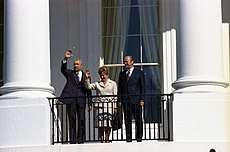
When Edward Gierek succeeded Gomułka as the head of state in 1970, he took decisive measures to boost economic growth and develop modern infrastructure.[3] Gierek, a more liberal figure than his predecessor, was determined to make Poland the wealthiest and most economically significant communist country of the Eastern Bloc.[4] However, these ideas prompted resistance from hardline communist leadership as the reform would effectively abandon the fundamental principles of a centrally planned Marxist economy. The grip and emphasis on state-owned enterprises and state-controlled prices or trade was eventually loosened. Small private businesses began to appear and Poland recorded temporary growth in GDP and an improvement in living conditions.[5][6]
Gierek maintained close ties with the United States, which he subsequently used for diplomatic and economic purposes.[6] In order to continue with the reforms, large sums of money were borrowed from creditors in the Western Bloc.[7] These sequential and uninterrupted loans were primarily targeted at establishing heavy industry, mines or manufacturing facilities that would produce goods for export.[7][8] The projected income from the exports would then be used to pay off the debt. Apart from financing the economic sector, the money was spent on social housing and on expanding road connections, for example the first fully operational highway linking Warsaw with industrial Silesia was opened for traffic in 1976.[9] Furthermore, over 1.8 million plattenbau flats were constructed to house the growing population. Agricultural output rose by nearly 22% between 1971 and 1975, and industrial production by 10.5% annually.[10][11] Gierek also initiated the construction of Warszawa Centralna, Europe's most modern railway station at the time.[12][13][14][15]
Crisis; debt, rationing and shortages (1976-1981)
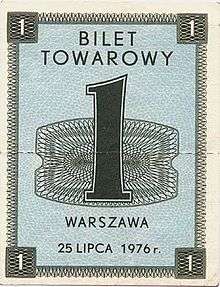
As expenditures increased and debts accumulated, the West would no longer grant Poland loans. Moreover, the 1973, June 1976 protests and 1979 oil crises affected the fragile economy. Due to previous GDP growth, higher income and expanded industries, the demand for certain goods and consumption surged.[16][17] New factories and state enterprises required imported fuel, materials and a workforce to operate production lines.[18] Soon, the country started exporting locally-produced stock designated for the Polish populace, thus resulting in widespread shortages.[19] Because the remaining assets were directed at production, exports and debt repayment, the state also reduced imports to minimize expenses.
In 1976, the communist government introduced ration cards for sugar.[20] Meat, processed food and dairy followed.[21] Confectionery, cocoa, coffee, rice, tobacco and other goods not produced in Poland were so heavily rationed that they were almost permanently unavailable.[22][21] Due to the constant lack of tobacco, ordinary cigarettes became a form of new currency on the black market.[23] The living standards began to sharply decline; the supply of imported goods was kept to a low minimum and the county was forced to export everything it could, including coal necessary for basic heating and power plants. Power outages were commonplace.[24] By 1980, the debt accounted to over US$23 billion, then almost half of Poland's nominal GDP.[25]
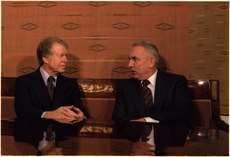
At the same time, the newly-founded Solidarity movement encouraged farmers to refrain from selling agricultural products (wheat, grain, fruit and others) to the state as a sign of protest. The actual lack of goods on the market and in stores was caused by the fact that production stopped due to the strikes organized by Solidarity.[26] In 1980, the national income fell by 6% compared to previous year, and in 1981 by 12%.[27] The number of exports declined by 4.2%. Mismanagement and wastefulness were abundant.[28]
On 6 September 1980, Gierek was dismissed from his office, expelled from the Polish United Workers' Party (possibly under the pressure from the Soviet Union) and falsely charged with corruption.[29][30] A year later, on 10 September 1981, the Soviet authorities informed the Polish government that in connection with the prevailing situation in Poland the USSR would cut oil supply to Poland by 64% and gas by 47%.[31] The import of diesel from the Soviet Union was terminated immediately.[31] This action was intended to force the Polish communist authorities to suppress the demonstrations and dissolve Solidarity.[32] The situation was already dire and gradually worsened, which only fueled anti-communist sentiment. A civil war was hanging by a thread.[33]
In 1981, Poland notified Club de Paris (a group of Western-European central banks) about its insolvency, which caught the attention of the entire world.[34]
Introduction, restrictions, patrols
Secret preparations and provocation
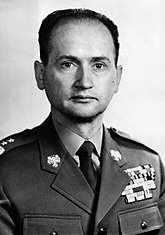
After the short tenure of Stanisław Kania, General and Minister of Defence Wojciech Jaruzelski was chosen as the new First Secretary. Before assuming office, Jaruzelski ordered the Polish General Staff to update plans for a nationwide martial law on 22 October 1980.[35] In November 1980, the Ministry of Internal Affairs planned to potentially facilitate thousands of oppositionists in state prisons and places of internment.[36]
On 5 December 1980, Kania spoke of the preparations relating to martial law at the Warsaw Pact Summit in Moscow.[37][38] He presented his own view of how to weaken Solidarity and insisted that a "psychological-operational method" would be most appropriate to prevent violence.[39] This method entailed strong propaganda[39] against the movement and deploying Secret Services (SB) to go undercover and infiltrate Solidarity headquarters in the hope of creating internal conflicts within the opposition. General Jaruzelski was not fully satisfied with the plan, and, in case of failure, already planned radical actions involving the army. Stanisław Kania warned Brezhnev that an armed intervention from the Soviet side to aid Jaruzelski would be met "with a violent reaction, or even with a national uprising"[40] that would shake the politics of the Eastern Bloc.[40]
Zbigniew Brzezinski, chief security advisor to US President Jimmy Carter, stated that if the Soviet Union would undertake an armed intervention in Poland, the US would strike back in a riposte manner.[41] According to historian and publicist Paul Kengor, the then US President Ronald Reagan considered sending American troops to Poland to scare off the Soviets.[42] This claim was not supported by Brzezinski nor by Richard Pipes from Harvard University.[42] Kengor then elaborated that Reagan eventually abandoned the plan after he was convinced by his own advisors that the US army stationed across Europe is less capable and much weaker than the Soviet forces.[42] The United States eventually struck back with economic sanctions against Poland and the USSR.[41]
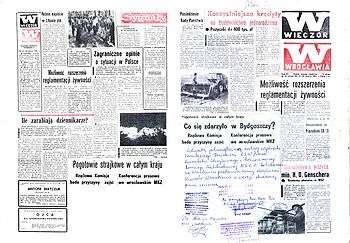
In February 1981, the Ministry of National Defence and Ministry of the Internal Affairs carried out a training scenario, the purpose of which was to explore how martial law will be introduced.[43] The ministries agreed that martial law should be preceded by appropriate propaganda calling for its support, and the decision itself should be based on a pretext that it would bring peace and stability for the society.[44] It was also highlighted that martial law must occur before the fully mobilized Fighting Solidarity and its allies organize a general strike that would paralyze the entire country.[44] By March, the situation escalated after the Bydgoszcz events, in which local Solidarity delegates invited for a Regional National Council meeting in Bydgoszcz to discuss potential strikes were beaten and abused by the Citizens' Militia (MO).[45] The event, which was to feature in newspapers as a provocation, was concealed by censors. On 27 March, Solidarity organized a warning strike directed at the government, but, on 30 March, Lech Wałęsa met with Mieczysław Rakowski and a compromise was achieved.[46] The general strike was called off and the situation stabilized for a short period.[46]
In July, the Soviets increased their military presence in the military base at Borne Sulinowo, where the Red Army stationed per Warsaw Pact agreement as in all other Eastern Bloc countries.[47] Without notifying the Polish authorities, the Soviets unexpectedly sent over 600 tanks to Borne Sulinowo. A month later, commander-in-chief of the Warsaw Pact, Viktor Kulikov, requested that Soviet military advisors are to be placed in the Polish General Staff and assigned to nearly all Polish regiments. It is suspected that Kulikov, acting on behalf of the Soviet Union, was tasked with sending undercover KGB agents to monitor the situation in Poland from the Polish military's perspective. His request, however, was immediately denied by the Polish government.[47]
Over 25,000 posters announcing martial law were secretly printed in the USSR, transported to Poland by airplane and hidden in the large building housing the Ministry of Internal Affairs.[48] The full extent of the actions undertaken by Jaruzelski to instigate martial law was not known by even some of the highest notables in the Central Committee of the Polish United Workers' Party or the Polish Sejm.[49]
12-13 December 1981; Operations Fir and Azalea
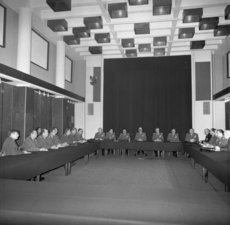
On 12 December 1981, shortly before midnight, the Polish Council of State gathered in Warsaw's Belweder Palace and approved nationwide martial law. Simultaneously, the Military Council of National Salvation (WRON - Wrona is translated as "Crow") was founded and its members were high-ranking generals or military officers in the Polish People's Army, who were in charge of the military junta. The generals and officers later became known to the public as evil "Crows", in relation to the Polish name of the council.
At precisely 00:00 (12:00 a.m.), the Motorized Reserves of the Citizens' Militia (ZOMO) began "Akcja Jodła" (English: Operation Fir) and arrested the first members of Solidarity who were at close reach.[50][51] They were then placed in previously-prepared detention facilities.[51] In total, between 70,000 and 80,000 soldiers of the People's Army and 30,000 functionaries of the Ministry of Internal Affairs (including SB, ZOMO and the Militia) were deployed for action. Around 1,750 tanks, 1,900 armoured combat vehicles, 500 militarized transport units, 9,000 cars and several helicopter squadrons were in service.[35][1][52] 25% of all units concentrated in the capital, Warsaw, or in surrounding localities.
Preceding Jodła was "Akcja Azalia" (English: Operation Azalea), which began at around 22:30 (10:30 p.m.) on 12 December.[53][54] Per Azalea, the SB secret services, paramilitary troops, the Militia, ZOMO and Border Protection Troops stormed 451 telecommunications exchange facilities and cut telephone lines to allegedly prevent the spread of misinformation.[54] However, the operation's true purpose was preventing Solidarity from contacting its branches in other cities to mobilize protesters. Radio and television stations were also besieged.[53] Any volunteers wishing to assist in the arrests were drafted into ORMO.
The Polish Radio informed about martial law being imposed at a 06:00 (6:00 a.m.) audition, and transmitted the speech made by General Jaruzelski.[55] Telewizja Polska network and its chief news program Dziennik (English: Journal) aired the speech in a slightly modified version.[56] The declaration was watched by millions of Polish citizens despite the early hour.
16 December 1981; Wujek Coal Mine
Three days after restrictions were imposed, miners at the Wujek Coal Mine in the industrial city of Katowice began striking against the declaration of martial law by General Jaruzelski.[57] Most of the miners and workers at Wujek were allied with the Solidarity Movement, with its leaders boycotting the state industries. Furthermore, coal was a precious fuel source that was used for generating electricity and heat, but also a major export material.[58] By selling and exporting coal, the communist government obtained enough money to gradually pay off the outstanding debt.[58] However, as Solidarity boycotted the mines in Silesia and demonstrations became more frequent, the production level dropped considerably along with revenue.
Jaruzelski perceived this as a threat to both state security and the economy. The forces used in the thrust consisted of eight ZOMO squads supported by ORMO, seven water cannons, three regiments with infantry combat vehicles and one tank regiment.[59] It was decided that the situation was far too serious for adopting the principles of morality to appropriately deal with the miners. Instead, the well-equipped ZOMO and army troops fired at the protesters with a "shoot to kill" technique.[59] 21 were wounded, 8 were killed on the spot and 1 died in hospital, with the youngest victim being only 19 years old.[60] The remaining crowd was violently dispersed. The miners repeatedly fought back with their work tools and, in retaliation, wounded dozens of soldiers and militiamen.[61] It was one of the deadliest single incidents during the martial law period.[62]
Gdańsk, Kraków, Lubin and continuing protests
On the same day as Wujek was pacified, a 30,000-strong[63] demonstration was held in the northern port city of Gdańsk. Clashes with ZOMO continued until 17 December and over 324 individuals were injured. The Militia used firearms and machine guns when the crowd approached the Polish United Workers' Party headquarters in Gdańsk.[64] A short and presumably cautionary gun salvo from the building's roof hit several people and wounded 4. 1 participant was killed.[65] The southern city of Kraków was also witnessing heavy demonstrations, with thousands marching on the street demanding an end to the martial law and communist rule.[66]
On the night of 29-30 April 1982, local miners in Wodzisław Śląski planted a bomb and blew up a monument dedicated to Soviet soldiers who liberated Poland from the Nazis in 1945.[67] It was the only incident involving explosives and the caught perpetrators became subsequently known as "Bombers from Silesia" (Polish: "Bombowcy ze Śląska").[67] The operation was a success as the monument was never reconstructed, though the bombers were sentenced and jailed soon after. Other suspects and hundreds of other miners across Silesia were sacked and removed from their job posts, which further weakened the economy.
In May 1982, the protests convened by Solidarity were receiving less attention and the struggle against the government was evidently weakening. However, by August, the social unrest again surged. On 31 August 1982, demonstrations took place in around 66[68] towns and cities, with at least 18 in the southwestern province of Lower Silesia. In Wrocław, one of the main centers of Fighting Solidarity, several thousand people for many hours clashed with ZOMO units.[69] One demonstrator was killed by a bullet.
The copper-mining town of Lubin also became a hotspot for Solidarity-led rallies.[70] On that day, the gathered people sang the Polish national anthem and chanted slurs and slogans against the communist regime, against the military junta with Jaruzelski as its head and against the Soviets. After approximately 30 minutes, the rally of 2,000[70] was surrounded by the Militia, armed with AK-47 assault rifles. In response, agitated protesters shouted slurs such as "pigs", "bandits", "Gestapo", "murderers" and "servants of Brezhnev".[71] An unsuccessful attempt was made at building a barricade, but the government units were able to pass through and dispersed the first group with tear gas. When the demonstrators regrouped and formed a second wave, ZOMO opened fire and wittingly murdered 2 men. The now infuriated crowd began continuous attacks and the Militia shot several more times, injuring one more man at the back of his head. He died in hospital a few days later. Reinforcements were sent from Legnica[72] and the new deployees were organized into so-called "raid groups" in Nysa vans.[70][73] These groups roamed the streets, often attacking casual passers-by.[73] Immediately after the protest was pacified, security forces began the destruction of any evidence to conceal the crime.[74] During the night of 31 August–1 September, the streets were cleared, with all shells and bullets taken for analysis. On 2 September, authorities ordered the repairs of damaged buildings; broken windows were replaced and traces of bullets on the walls were covered with plaster.[74] The investigation, despite consistent statements made by witnesses of the massacre, was closed.
To avoid further escalation, on 14 November, Lech Wałęsa was released from custody in a detention camp. Following his release, no major demonstration took place.[75]
Law, rules and censorship
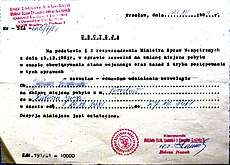
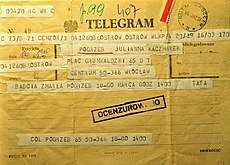
From the very beginning in December 1981, a strict curfew was imposed from 19:00 (7:00 p.m.) until 6 in the morning.[76] The time of curfew was later adjusted to 22:00 (10:00 p.m.)–06:00.[77] Night walks or escapades were forbidden and street patrols were commonplace. The WRON Military Council sealed off the country's borders, closed all airports[78] and road access to main cities was restricted. Special permission passes were issued for individuals in extraordinary cases.[79] Telephone lines were disconnected, mail was subjected to renewed postal censorship,[80] all independent political organizations were criminalized and lessons in schools and universities temporarily suspended.[81]
The government imposed a six-day workweek while the mass media, public services, healthcare services, power stations, coal mines, seaports, railway stations, and most key factories were placed under military management, with employees having to follow military orders or face a court martial. As part of the crackdown, media and educational institutions underwent "verification", a process that tested each employee's attitude towards the regime and to the Solidarity movement; as a result, thousands of journalists, teachers and professors were banned from their professions. Military courts were established to bypass the normal court system, to imprison those spreading "false information".[82] In an attempt to crush resistance, civilian phone lines were routinely tapped and monitored by government agents.
Synopsis
During the initial imposition of martial law, several dozen people were killed. Official reports during the crackdown claimed about a dozen fatalities, while a parliamentary commission in the years 1989–1991 arrived at a figure of over 90.[83] Others were also killed and wounded during a massive second wave of demonstrations on 31 August 1982.
At the invitation of Jaruzelski, a delegation of the ruling Hungarian Socialist Workers' Party visited Poland between 27 and 29 December. The Hungarians shared with their Polish colleagues their experiences on crushing the "counterrevolution" of 1956. Earlier in the autumn of 1981, Polish television had broadcast a special film on the 1956 events in Hungary, showing scenes of rebels hanging security officers etc.[84]
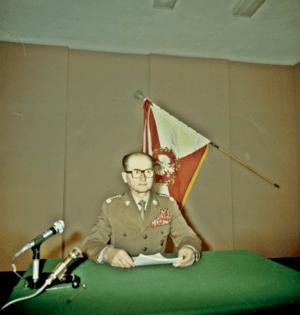 Jaruzelski in a TV studio announcing the introduction of martial law
Jaruzelski in a TV studio announcing the introduction of martial law The proclamation of martial law by the State Council
The proclamation of martial law by the State Council- Units of the Citizens' Militia and ZOMO race to disperse crowds of protesters
Economic impact

Even after martial law was lifted, a number of restrictions remained in place for several years that drastically reduced the civil liberties of the citizenry. It also led to severe economic consequences. The ruling military dictatorship instituted major price rises (dubbed "economic reforms"), which resulted in a fall in real wages. The resulting economic crisis led to the even more rationing of most basic products and materials.
As a consequence of the economic hardships and political repressions, an exodus of Poles saw 700,000 migrate to the West between 1981 and 1989.[85] A number of international flights were even hijacked in attempts to flee the country and its economic problems. Between December 1980 and October 1983, 11 Polish flights were hijacked to Berlin Tempelhof Airport alone.[86]
Around the same time, a group calling themselves the "Polish Revolutionary Home Army" seized the Polish Embassy in Bern, Switzerland on 6 September 1982, taking several diplomats as hostages. However, this turned out to be an apparent provocation by the communist Polish secret services aiming to discredit the Solidarity movement.[87]
International response
After the "Wujek" Coal Mine incident in Katowice on 23 December 1981, the United States imposed economic sanctions against the People's Republic of Poland. In 1982 the United States suspended most favored nation trade status until 1987 and vetoed Poland's application for membership in the International Monetary Fund.[88]
Pope John Paul II wrote a letter to the Primate of Poland, Stefan Cardinal Wyszynski, in which he called for peace talks between the state and the workers, supporting the Poles' "undeniable right to resolve their problems by themselves".
Aftermath
Ruling of unconstitutionality
After the fall of Communism in Poland in 1989, members of a parliamentary commission determined that martial law had been imposed in clear violation of the country's constitution which had authorized the executive to declare martial law only between parliamentary sessions (at other times the decision was to be taken by the Sejm). However, the Sejm had been in session at the time when martial law was instituted. In 1992 the Sejm declared the 1981 imposition of martial law to be unlawful and unconstitutional.
Soviet intervention debate
The instigators of the martial law, such as Wojciech Jaruzelski, argue that the army crackdown rescued Poland from a possibly disastrous military intervention of the Soviet Union, East Germany, and other Warsaw Pact countries (similar to the earlier interventions in Hungary in 1956 and Czechoslovakia in 1968).[89] Public figures who supported the introduction of martial law (including some of the right-wing figures like Jędrzej Giertych) would also refer to that threat.
In 2009, archive documents hinted that in a conversation Jaruzelski had with Viktor Kulikov, a Soviet military leader, Jaruzelski himself begged for Soviet intervention as his domestic control was deteriorating.[90][91] Jaruzelski responded by claiming the document was 'just another falsification' and denied all charges.[92]
Declaration script
Led by General of the Army Wojciech Jaruzelski, the Military Council of National Salvation (Wojskowa Rada Ocalenia Narodowego, WRON) usurped for itself powers reserved for wartime, hence the name. The plan was presented to the government of the Soviet Union before the declaration in March 1981.
Appearing on Polish television at 6:00 a.m. on 13 December 1981, General Jaruzelski said:[93]
Today I address myself to you as a soldier and as the head of the Polish government. I address you concerning extraordinarily important questions. Our homeland is at the edge of an abyss. The achievements of many generations and the Polish home that has been built up from the dust are about to turn into ruins. State structures are ceasing to function. Each day delivers new blows to the waning economy./.../
The atmosphere of conflicts, misunderstanding, hatred causes moral degradation, surpasses the limits of toleration. Strikes, the readiness to strike, actions of protest have become a norm of life. Even school youth are being drawn into this. Yesterday evening, many public buildings remained seized. The cries are voiced to physical reprisals with the 'reds', with people who have different opinions.
The cases of terror, threats and moral vendetta, of even direct violence are on the rise. A wave of impudent crimes, robberies and burglaries is running across the country. The underground business sharks' fortunes, already reaching millions, are growing. Chaos and demoralization have reached the magnitude of a catastrophe. People have reached the limit of psychological toleration. Many people are struck by despair. Not only days, but hours as well are bringing forth the all-national disaster./.../
Citizens!
The load of responsibility that falls on me on this dramatic moment in the Polish history is huge. It is my duty to take this responsibility - concerning the future of Poland, that my generation fought for on all the fronts of the war and for which they sacrificed the best years of their life. I declare, that today the Military Council of National Salvation has been formed. In accordance with the Constitution, the State Council has imposed martial law all over the country. I wish that everyone understood the motives of our actions. A military coup, military dictatorship is not our goal./.../
In longer perspective, none of Poland's problems can be solved with the use of violence. The Military Council of National Salvation does not replace constitutional organs of power. Its only purpose is to keep the legal balance of the country, to create guarantees that give a chance to restore order and discipline. This is the ultimate way to bring the country out of the crisis, to save the country from collapse./.../
I appeal to all the citizens. A time of heavy trials has arrived. And we have to stand those in order to prove that we are worthy of Poland.
Before all the Polish people and the whole world I would like to repeat the immortal words:
See also
- Cold War
- Able Archer 83
- Fighting Solidarity
- Pacification of Wujek
- Telephone tapping in the Eastern Bloc
- Soviet reaction to the Polish Crisis of 1980-1981
References
- "The Day Poland Stood Still: Memories from the Introduction of Martial Law". Culture.pl.
- Poland marks communist crackdown, BBC News, 13 December 2006
- Grala, Dariusz T. (April 11, 2005). "Reformy gospodarcze w PRL, 1982-1989: próba uratowania socjalizmu". Wydawn. TRIO – via Google Books.
- "Edward Gierek i jego koncepcja "drugiej Polski"". nowahistoria.interia.pl.
- "Wojsko ludowe". April 11, 1980 – via Google Books.
- Sawicki, Stanislaw J.; Sawicka-Brockie, Theresa (April 11, 1982). Embattled Poland. Victoria University Press. ISBN 9780705507967 – via Google Books.
- Bühler, Pierre (April 11, 1999). Polska droga do wolności, 1939-1945. Dialog. ISBN 9788386483952 – via Google Books.
- Petrozolin-Skowrońska, Barbara (April 11, 1997). Nowa encyklopedia powszechna PWN. Wydawn. Nauk. PWN. ISBN 9788301110970 – via Google Books.
- Wegner, Jacek (April 11, 1997). "Sternicy: opowieść o 10 przywódcach PPR-PZPR od Nowotki do Rakowskiego". Arcana – via Google Books.
- https://www.cia.gov/library/readingroom/docs/CIA-RDP86T00608R000500200020-4.pdf
- file:///C:/Users/User/Downloads/Harmonijny_rozwoj_czy_droga_ku_p.pdf
- "Polityka". Wydawn. Prasowe "Polityka". April 11, 2008 – via Google Books.
- Chomątowska, Beata (July 8, 2015). Pałac. Biografia intymna. Otwarte. ISBN 9788324040384 – via Google Books.
- "Dworzec Centralny wpisany do rejestru zabytków". www.mwkz.pl.
- "Miliardy na budowę. Tak powstawał Dworzec Centralny". TVN Warszawa.
- "Polska spłaciła dług Gierka. Po 40 latach". Wprost. October 29, 2012.
- "Wyścig z długiem". Forbes.pl.
- Bühler, Pierre (April 11, 1999). Polska droga do wolności, 1939-1945. Dialog. ISBN 9788386483952 – via Google Books.
- Zalewska, Joanna; Cobel-Tokarska, Marta (December 1, 2014). Od obyczaju do mody: Przemiany życia codziennego. Akademia Pedagogiki Specjalnej. ISBN 9788362828913 – via Google Books.
- "Rocznik". Wydawn. Nauk. PWN. April 11, 2002 – via Google Books.
- "KWOTY CUKRU - najnowsze wiadomości gospodarcze i finansowe - Gospodarka.gazeta.pl". gazetapl.
- "Życie na kartki". PolskieRadio.pl.
- http://www.ippt.pan.pl/Repository/zycie_%20w_ciekawych_czasach_15_10_2012.pdf
- Bernacki, Włodzimierz; Górska, Aleksandra; Karolczuk-Kędzierska, Monika (April 11, 2009). Kronika komunizmu w Polsce. Kluszczyński. ISBN 9788374470872 – via Google Books.
- "Zakłamywanie prawdy o długach Gierka". December 16, 2012.
- "Gierek siedział na wulkanie, który w końcu eksplodował - Muzeum Historii Polski". muzhp.pl.
- "Polska Gierka". Onet Wiadomości. February 7, 2003.
- Ziemkiewicz, Rafał (March 10, 2017). Polactwo. Fabryka Słów Sp.zo.o. ISBN 9788375748772 – via Google Books.
- Śmierzchalski-Wachocz, Dariusz (April 11, 2007). Partia komunistyczna wobec Kościoła i przejawów wiary katolickiej w swoich szeregach na przykładzie Środkowego Nadodrza w latach 1945-1989. Apostolicum. ISBN 9788370315696 – via Google Books.
- file:///C:/Users/User/Downloads/Dyskusja-wokol-ksiazki-Rozliczenia-z-ekipa-Gierka-19801984-Warszawa-6-wrzesnia-2.pdf
- Andrzej Krajewski, „Gazowa pętla”, Dziennik Gazeta Prawna nr 111/2016.
- "NSZZ - Wiadomości". Onet Wiadomości.
- "Strona główna - Reportaż - polskieradio24.pl". www.polskieradio24.pl.
- "Club de Paris". www.clubdeparis.org.
- From Solidarity to Martial Law: The Polish Crisis of 1980–1981: A Documentary History by Andrzej Paczkowski, Malcolm Byrne. Central European University Press, Budapest 2007. p. xxxiii
- "38 lat temu komunistyczne władze wprowadziły w Polsce stan wojenny". TVN24.
- "Koniec epoki Breżniewa". dzieje.pl.
- https://www.polityka.pl/tygodnikpolityka/historia/1533463,1,stanislaw-kania---przeciwnik-stanu-wojennego.read
- "Czemu stan wojenny wprowadzono dopiero w nocy z 12 na 13 grudnia 1981 r.?". Przystanek Historia.
- "Wyborcza.pl". wyborcza.pl.
- "Zbigniew Brzeziński i jego strategia wygrania Zimnej Wojny". June 23, 2018.
- "Wyborcza.pl". wyborcza.pl.
- IPN, Pamięć pl-portal edukacyjny. "16 lutego 1981 roku w Warszawie przeprowadzono wspólną "grę sztabową" MON i MSW, podczas której testowano plany Sztabu Generalnego WP i MSW dotyczące wprowadzenia stanu wojennego". Pamięć.pl - portal edukacyjny IPN.
- file:///C:/Users/User/Downloads/Ruzikowski_Stan_wojenny_w_Warszawie.pdf
- MacEachin, Douglas J. (November 1, 2010). U. S. Intelligence and the Confrontation in Poland, 1980-1981. Penn State Press. ISBN 9780271046525 – via Google Books.
- Weber, Wolfgang (April 11, 1989). Solidarity in Poland, 1980-1981 and the Perspective of Political Revolution. Mehring Books. ISBN 9780929087306 – via Google Books.
- Benjamin Weiser (2005). Ryszard Kukliński. Życie ściśle tajne. Warszawa: Świat Książki. ISBN 83-7391-673-3.
- Ryszard Terlecki: Miecz i tarcza komunizmu. Historia aparatu bezpieczeństwa w Polsce 1944-1990, Kraków 2007, p. 270–271.
- file:///C:/Users/User/Downloads/akt-oskarzenia-S-101-04-Zk_2%20(1).pdf
- Kamiński, Łukasz; Waligóra, Grzegorz (April 11, 2010). "NSZZ Solidarność, 1980--1989: POLSKA ZACHODNIA". Instytut Pamięci Narodowej, Komisja Ścigania Zbrodni Przeciwko Narodowi Polskiemu – via Google Books.
- Narodowej, Instytut Pamięci. "Grzegorz Majchrzak – Stan wojenny, kryptonim "Jodła"". Instytut Pamięci Narodowej.
- Dudek, Antoni; Marszałkowski, Tomasz (April 11, 1999). Walki uliczne w PRL 1956-1989. Wydawn. Geo. ISBN 9788386124305 – via Google Books.
- "Wypowiedzi na posiedzeniach Sejmu". www.sejm.gov.pl.
- "Akcja Azalia | Blisko Polski".
- 33 lata temu wprowadzono w Polsce stan wojenny, 2014-12-13, p. polskieradio.pl
- Wiktor Ferfecki, Joanna Idziak (2009-12-13), Nieznana wersja przemówienia gen. Jaruzelskiego, p. tvp.info
- Narodowej, Instytut Pamięci. "Pacyfikacja kopalni "Wujek" – największa zbrodnia stanu wojennego". Instytut Pamięci Narodowej.
- "Polityka". Wydawn. Prasowe "Polityka". April 11, 2011 – via Google Books.
- "Pomnik Dziewięciu z Wujka oraz Muzeum–Izba Pamięci Kopalni Wujek w Katowicach". silesia.travel.
- "Pacyfikacja kopalni Wujek: Po 30 latach ujawnił się i mówi: Widziałem dramat na Wujku... Dlaczego tyle lat milczał?". plus.dziennikzachodni.pl. December 16, 2018.
- "pacyfikacja kopalni Wujek". pacyfikacja kopalni Wujek - pacyfikacja kopalni Wujek - Wydarzenia - Wiedza - HISTORIA: POSZUKAJ.
- "37 lat temu zginęło 9 górników Kopalni Wujek – największa tragedia stanu wojennego". dzieje.pl.
- "Region Gdański 13 XII 1981- 22 VII 1983". 13grudnia81.pl.
- grudnia 2016, przez Marek Kozubal-12 (December 12, 2016). "Stan wojenny zaskoczył wszystkich".
- "37. rocznica morderstwa Antoniego Browarczyka". Gdańsk Strefa Prestiżu. December 16, 2018.
- "Orła WRON-a nie pokona! Stan wojenny w Polsce". Polska Times. December 13, 2019.
- ""Bombowcy ze "Śląska" - zapomniana historia • Wodzisław Śląski". www.nowiny.pl.
- "Sierpniowe manifestacje w 1982 r." dzieje.pl.
- "Manifestacja we Wrocławiu 31 sierpnia 1982 roku: Kiedy ZOMO uciekało w panice". nowahistoria.interia.pl.
- "Wydarzenia lubińskie. Krwawy sierpień '82 w Zagłębiu Miedziowym". PolskieRadio.pl.
- "Widziałem, jak zrobili mu dziurę w głowie. Myślicie, że to zabawa?". www.fakt.pl. August 31, 2017.
- "Sierpień 82". 31sierpnia1982.pl.
- "Lubin 1982. Zbrodnia (nie)ukarana". dzieje.pl.
- IPN, Pamięć pl-portal edukacyjny. "POLOWANIE NA LUDZI. ZBRODNIA LUBIŃSKA 31 SIERPNIA 1982 ROKU". Pamięć.pl - portal edukacyjny IPN.
- "Lech Wałęsa". www.fakt.pl.
- "Życie codzienne w czasie stanu wojennego | Blisko Polski".
- "Stan Wojenny". Sciaga.pl.
- "Kalendarium stanu wojennego - Rocznica wprowadzenia stanu wojennego - raport specjalny - RMF24.pl". www.rmf24.pl.
- https://ipn.gov.pl/ftp/13grudnia81/czytelnia/Stan_wojenny_Teka_edukacyjna.pdf
- Komaniecka, Monika (December 12, 2016). "Cenzura w stanie wojennym". Dziennik Polski.
- "38 lat temu wprowadzono stan wojenny. "Ojczyzna nasza znalazła się nad przepaścią"". wiadomosci.dziennik.pl. December 13, 2019.
- 1981: Martial law, BBC
- Ofiary stanu wojennego i lat następnych do 1989 Archived 2014-01-08 at the Wayback Machine by Piotr Lipiński
- Paczkowski, Andrzej; Byrne, Malcolm; Domber, Gregory F.; Klotzbach, Magdalena (January 1, 2007). From Solidarity to Martial Law: The Polish Crisis of 1980-1981 : a Documentary History. Central European University Press. ISBN 9789637326967 – via Google Books.
- Kierzkowski, Henryk; Okólski, Marek; Wellisz, Stanislaw (April 11, 1993). Stabilization and Structural Adjustment in Poland. Psychology Press. ISBN 9780415100243 – via Google Books.
- "A Symbol Of Allied Solidarity Will Disappear. Berlin - The Atlantic Times". Archived from the original on July 7, 2011.
- "Terrorist Organization Profile: Polish Revolutionary Home Army".
- "Poland - The United States". countrystudies.us.
- Jaruzelski says martial law saved Poland, Euronews, 02/10/08
- "Informacje i wydarzenia | Gospodrka, Polityka, Finanse - newpolandexpress.pl". newpolandexpress.pl. Archived from the original on October 9, 2011.
- "Jaruzelski Again Denies Seeking Soviet Aid Against Solidarity". RadioFreeEurope/RadioLiberty.
- https://www.kyivpost.com/article/content/russia/polands-jaruzelski-denies-he-invited-soviet-army-54694.html
- The original is available at Konflikty.pl Archived 2012-11-12 at the Wayback Machine
Further reading
- Leopold Labedz, Poland Under Jaruzelski: A Comprehensive Sourcebook on Poland During and After Martial Law
- George Sanford, Military Rule in Poland: The Rebuilding of Communist Power, 1981–1983
External links
| Wikimedia Commons has media related to Martial law in Poland. |
